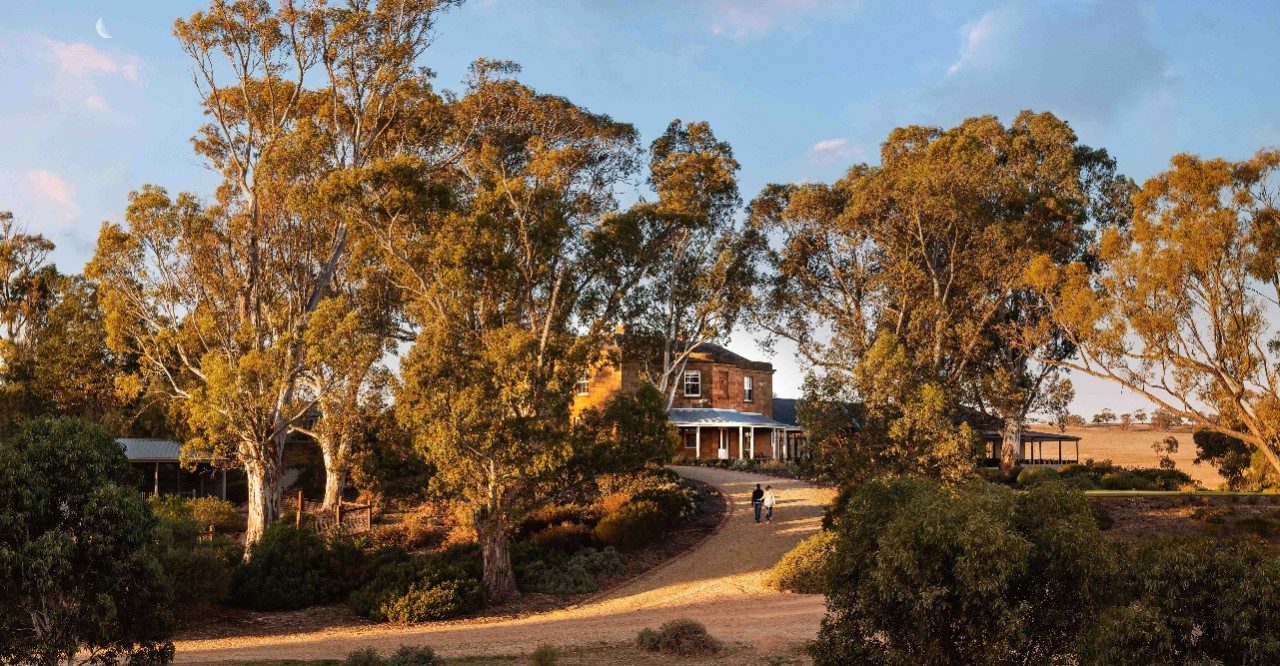Why Kingsford The Barossa Should Be Your Next Getaway

The newly refurbished retreat, Kingsford the Barossa, is as enticing as the shiraz in this serene wine region.
“What makes this special isn’t just the age of the vines,” Kaesler winemaker Reid “Boz” Bosward tells me as he holds up a glass of Langmeil Freedom 1843, spoils from the oldest known shiraz vineyard in the world. “It’s the age of the soils.”
For millions of years the elements have been slowly softening the landscape of South Australia’s Barossa Valley, traditional lands of the Ngadjuri, Peramangk and Kaurna peoples, eroding craggy mountains into rounded hills of mineral-rich sands, crumbly brown dirt and deep chocolatey clay that create complex wines.
The bottled fruit of venerable vines fills the vaults of an underground wine tunnel at stately Kingsford The Barossa. Thoughtfully updated and full of whimsy, the property has four elegant new suites that sit opposite one entrance to the tunnel, near the traditional German bowling alley or kegelbahn. At the tunnel’s other end, a secret door straight out of a spy movie leads through the original cellar and up to the 1856 homestead, which is all mod-cons and historic details and overlooks rolling meadows and creeks fringed with native vegetation.

The next morning, I wake to a sky tinted apricot and wander past several watchful ’roos to a private clawfoot tub sheltered under wattles with yellow puffball blooms and flowering gums. A soundtrack of chirping galahs and hundreds of invisible frogs makes it feel more like the bush than the Barossa I’m used to; there’s not a vine to be seen in any direction. It isn’t until I leave the property that I glimpse a plot of perfectly aligned trellises and more are revealed as I head east.
At Mengler’s Hill Lookout I stop to get a sense of the valley. The vineyards that seemed so uniform at ground level form a herringbone pattern from this height. Wineries and villages stand out like islands in the green, stitched together by narrow roads and creeks.
In addition to winemaking, the Barossa is a fertile agricultural region and as I drop back down into the valley, I get the chance to taste the best of it at Casa Carboni in Angaston. Its Taste of Barossa cooking class pairs recipes from chef Matteo Carboni’s homeland of Italy with whatever’s in season locally, though one part of the recipe never changes.
“There are just two ingredients in the pasta: flour and egg,” Carboni informs me over coffee, before reaching a conclusion I’m not sure I entirely agree with: “so it cannot be that hard.” Under his watchful eye I’m soon busy making the dough for piadina, gnocchi and rich yellow pasta that will form the basis of a four-course meal.
A neighbour drops by with a bag of sage from his garden and a buzzing phone turns out to be a message from Carboni’s “stinging-nettle dealer”. I cut the pasta and fill it with pumpkin, parmesan and nutmeg to make ravioli. To my delight, the flavour bombs survive cooking and are delicious tossed in a sauce of butter and fresh sage.
Ten minutes down the road, I meet sixth-generation grapegrower Damien Tscharke at his eponymous winery in Marananga. He’s excited about dirt in a way only a farmer could be, describing the vineyard floor as a “giant solar panel” that produces organic carbon, which enriches the soil. His philosophy is simple: work with the environment rather than against it.
Tscharke’s care is repaid with fruit that makes superb wines, as well as in other ways. On a walk through his most prized vineyards, he points out a patch of scrub he’s preserved as a wildlife corridor and the blue gum where a pair of brown falcons nest and protect his fruit from rosellas. Beyond a nearby church steeple, the valley rolls on. “I tell anyone who thinks it’s flat to go ride a bike around for a day,” he says with a wry smile. “But one of our strengths as a region is the variety [this topography] creates.”
As I head back to Kingsford, the sun illuminates fields where herds of cattle graze, in a scene that could have been pulled from Renoir’s easel. Just as the landscape obscures nearby vineyards, the Georgian façade of the homestead ahead hides the luxurious updates within. Another reminder that there’s plenty beneath the surface in the Barossa.



